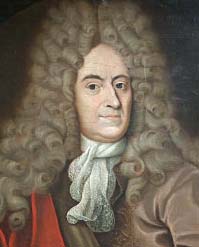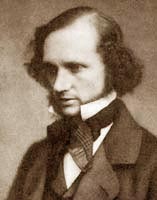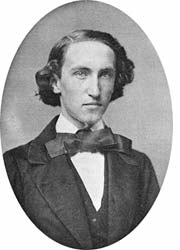![]()
![]()
We are all familiar with hot and cold because of nerve sensors which detect the gain or loss of heat from our skin. But those sensors only provide a rough estimate of how hot or cold our surroundings are. To more precisely measure of the degree of hotness or coldness a number of people have invented instruments and accompanying definitions.

 Generally most objects expand when they are heated and contract when cooled. Different materials have different rates of expansion. By comparing the expansion of two different materials, it is possible to formulate a measure of temperature.
Generally most objects expand when they are heated and contract when cooled. Different materials have different rates of expansion. By comparing the expansion of two different materials, it is possible to formulate a measure of temperature.
The first commonly used temperature scales were devised to measure the weather. In 1701, the Danish Ole Christensen Rømer (b1644, d1710, portrait right→) created one of the first practical thermometers using red wine in a glass container. For a given temperature rise, the wine expands more than the glass so that the wine's meniscus (slightly curved top surface) in the narrow neck of a glass container will rise noticeably. Rømer created a temperature scale for the neck of the glass container such that with the thermometer immersed in a mixture of salt and ice, the meniscus was marked as zero and when in boiling water, it was marked as 60.
 Daniel Gabriel Fahrenheit (b1686, d1736, ←portrait at left) devoted most of his life to creating precision meteorological instruments in Amsterdam. After meeting Rømer in Copenhagen, in 1714 Fahrenheit substituted mercury in his glass thermometer. Fahrenheit thought it would be practical to use a scale in which zero corresponded with the coldest temperature normally encountered and 100 corresponded to the hottest temperature. Fahrenheit, being an instrument manufacturer realized the importance of not only choosing two easily obtainable calibration temperatures, but a scale which could be marked by repeated division of the space between the calibration temperatures. He initially used a mixture of salt and ice as zero and the temperature of the human body (
Daniel Gabriel Fahrenheit (b1686, d1736, ←portrait at left) devoted most of his life to creating precision meteorological instruments in Amsterdam. After meeting Rømer in Copenhagen, in 1714 Fahrenheit substituted mercury in his glass thermometer. Fahrenheit thought it would be practical to use a scale in which zero corresponded with the coldest temperature normally encountered and 100 corresponded to the hottest temperature. Fahrenheit, being an instrument manufacturer realized the importance of not only choosing two easily obtainable calibration temperatures, but a scale which could be marked by repeated division of the space between the calibration temperatures. He initially used a mixture of salt and ice as zero and the temperature of the human body (held in the mouth or under the armpit of a living man in good health
) a value of 96. (One degree is obtained by dividing the separation in half 5 times, and by three once.) Fahrenheit later increased the range of his temperature scale by assigning boiling point of water a value of 212.
 Réne Antoine Ferchault de Réamur (b1683, d1757) created in 1731 a scale in which zero represented the freezing point of water and 80 represented its boiling point. The Réamur temperature scale became popular in France.
Réne Antoine Ferchault de Réamur (b1683, d1757) created in 1731 a scale in which zero represented the freezing point of water and 80 represented its boiling point. The Réamur temperature scale became popular in France.
In 1742, Swedish Anders Celsius (b1701, d1744, ←portrait at left) created an inverted centigrade temperature scale in which zero represented the boiling point of water and 100 represented the freezing point. Two years later Carl Linnaeus (b1707, d1778) suggested reversing Celsius' temperature scale so that zero represented the freezing point of water and 100 represented its boiling point. This centigrade scale was widely adopted largely because of a paper by Celsius, Observations on two persistent degrees on a thermometer, suggesting the importance of reliable calibration temperatures, and reported on experiments showing that the freezing point of water is independent of latitude and atmospheric pressure. Celsius also determined the dependence of the boiling of water on atmospheric pressure, and gave a rule for the determination of the boiling point if the barometric pressure deviates from a standard pressure. As a result the centigrade temperature scale gradually became popular throughout the world. The units of the centigrade temperature scale were designated degree centigrade (°C).
 Over a century later, William Thomson (Baron Kelvin of Largs, Lord Kelvin of Scotland, b1824, d1907, photograph right→) proposed in 1848 a thermodynamic temperature scale which assigned zero to the theoretical coldest possible temperature, thermodynamic absolute zero, and used a unit size equal to one degree centigrade. His scale was later named the Kelvin scale (°K).
Over a century later, William Thomson (Baron Kelvin of Largs, Lord Kelvin of Scotland, b1824, d1907, photograph right→) proposed in 1848 a thermodynamic temperature scale which assigned zero to the theoretical coldest possible temperature, thermodynamic absolute zero, and used a unit size equal to one degree centigrade. His scale was later named the Kelvin scale (°K).
Creating a similar absolute temperature scale to accompany the them more common Fahrenheit scale, William John Macquorn Rankine (b1820, d1872) proposed in 1859 a scale with zero as absolute zero, but used the Fahrenheit degree for its unit size. This Rankine scale is denoted by the symbol °R.
In 1948, the Ninth General Conference on Weights and Measures renamed centigrade scale to Celsius (°C) in honor of Anders Celsius. In 1954, the Tenth General Conference on Weights and Measures selected the degree Kelvin as the metric unit of thermodynamic temperature. The conference defined the degree Kelvin by assigning the exact value 273.16°K to the triple point of water (where gas, liquid, and solid phases may coexist in thermodynamic equilibrium). In 1967, the Thirteenth General Conference on Weights and Measures simplified degree Kelvin (°K) to just Kelvin (K). The conference redefined Celsius temperature as the thermodynamic temperature minus 273.15 Kelvin.
Knowing how to measure something isn't a guarantee that you have even a foggy notion of what is being measured! While temperature seemed related to what we feel as warm or cold, the cause of that warmth or cold remained obscure until a careful Newtonian analysis of atomic theory. And that required some confidence that this chemistry actually described reality. Recall that chemistry evolved out of the secret witchcraft of Persian, Arab, and Egyptian alchemists rather than the observations, mathematics and Greek logic used by physics. Until the 1905 mathematical analysis of Brownian motion by Albert Einstein, some prominent physicists regarded atoms as a chemist's unsupported fantasy. But by the middle of the 19th Century, some physicists began consideration of the physical implications of what became known as the kinetic molecular theory (= theory of moving collections of atoms).
The kinetic molecular theory was originated and developed by Robert Boyle (b 1627, d1691), Daniel Bernoulli (b1700, d1782), James Joule (b1818, d1889), A. Kronig (b1822, d1879), Rudolph Clausius (b1822, d1888), and Clerk Maxwell (b1831, d1879). It was found experimentally that the temperature of a gas (using the absolute Kelvin or Rankin scales), T, depends on the gas pressure, p, container volume, V, and number of contained molecules, n, by
 J. Willard Gibbs (b1839, d1903, ←photo at left) and Ludwig Boltzmann (b1844, d1906, photo at right→) helped create statistical mechanics which included thermodynamics explaining such properties as temperature. They assumed that pressure is due to the change of momenta of molecules striking the container walls. Since molecules are randomly moving in three dimensions, the calculation combined the time between collisions (determined by 1/3 of the root mean-square speed), and momenta change (twice the average speed times the total mass given by n times molecule mass, M).
J. Willard Gibbs (b1839, d1903, ←photo at left) and Ludwig Boltzmann (b1844, d1906, photo at right→) helped create statistical mechanics which included thermodynamics explaining such properties as temperature. They assumed that pressure is due to the change of momenta of molecules striking the container walls. Since molecules are randomly moving in three dimensions, the calculation combined the time between collisions (determined by 1/3 of the root mean-square speed), and momenta change (twice the average speed times the total mass given by n times molecule mass, M).
So it is now understood that a gas is a collection of loose, independent atoms or molecules, moving around randomly at average speeds measured by their temperature. When these freely moving particles strike the container walls, or any object in the gas, they bounce, creating a small push. With an enormous number of randomly moving particles in a sample of gas, the billions of tiny pushes average out to be a smooth pressure on the container walls and any object contained in the gas. If the gas is heated so the particles have more kinetic energy, the particles move faster exerting more pressure. If the container is flexible or allows particles to escape, the collection of particles expands and becomes less dense. So compared to surrounding, cooler gas, the warmer gas is lighter and floats upward.
![]()
to next experiment: Condensed Matter & Transitions
to menu for Nanochemistry, Colloidal & Physical Chemistry
to ie-Chemistry menu
to site menu